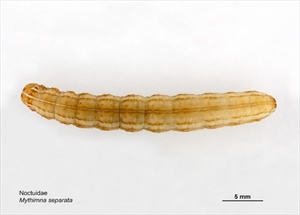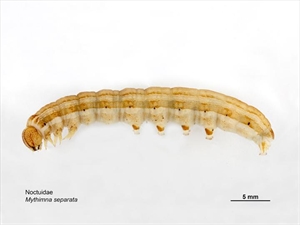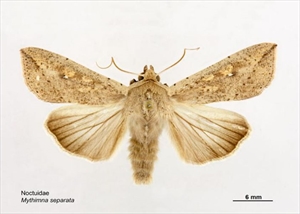Paddy armyworm, rice armyworm, oriental armyworm, rice ear-cutting caterpillar.
Pacific Pests, Pathogens, Weeds & Pesticides - Online edition
Pacific Pests, Pathogens, Weeds & Pesticides
Rice (maize) armyworm (331)
Mythimna separata; previously known as Pseudoaletia separata. It is a member of the Noctuidae.
Asia, Southeast Asia, Europe, Oceania. It is recorded from Australia, Cook Islands, Fiji, New Caledonia, New Zealand, Papua New Guinea, Samoa, Solomon Islands, Tonga, and Vanuatu.
Rice, maize, sorghum, sugarcane and small cereal grains are the main hosts, but it is also a pest of many food legumes, Chinese cabbage, sugar beet, and weeds in the grass family.
On rice, the larvae eat the leaves, often including the veins, and the inflorescence. Later, at grain filling, the larvae cut the panicles at the base so that they bend over or collapse. Plant in seedbeds are also attacked.
On maize, the mature larvae, climb the stems and eat the leaves from the edges; they are often found in the axils of leaves within piles of frass. Severe damage reduces the size of cobs. Young plants may be cut off below ground, or the leaves badly eaten.
The larvae are often a problem after rains and floods. The young larvae develop on grasses (e.g., Echinochloa and Setaria) and later move to the older rice plants.
On rice, eggs are laid in rows along a leaf blade (green or dead). The number of eggs laid by a moth during its life is from 500 to nearly twice that number. It depends if nectar is plentiful, and how soon the moth mates after emergence. At first, the larvae scrape the leaves to feed; later, they eat through the leaves.
Young larvae 'loop' as they move, and fall from leaves on silken threads when disturbed. Mature larvae do not loop, grow to 40 mm, and have a narrow, yellowish-white stripe along the back and two others at the sides (Photos 1-3). They are nocturnal, in the day concealed by foliage at the base of the plants or in cracks in the soil (in dryland rice). Adult forewings are pinkish-light brown with two pale spots, and the hindwings have prominent veins (Photos 4&5).
Spread occurs in several ways. In parts of Asia, the moth is migratory, traveling long distances by wing, assisted by weather systems. Spread over shorter distances occurs when food is scarce: late-stage larvae move in large numbers in search of new fields, hence the name 'armyworm'.
The impact on rice can be substantial if the attack comes when the crop is in ear as the spikelets are bitten off at the base. The impact is large when larvae move from field to field in search of food. The damage done by this moth is far greater on dryland rice, and is said to have declined in recent past decades as irrigated rice cultivation has increased.
Look for the larvae at the base of the rice plants; look for frassson the leaves, remembering that the larvae may not be present as they are nocturnal. A sex pheromone is available for this moth. Light traps, too, can be used for attracting adults and estimating the likelihood of outbreaks. Attraction is great if the light traps are baited with molasses or a mixture of wine, vinegar and sugar.
Thresholds for rice are nine larvae per m2 in the pre-panicle stage. Look for larvae weekly throughout the field as the larvae are not evenly distributed.
NATURAL ENEMIES
Releases of Cortesia ruficrus have been made with success in New Zealand, even though a hyperparasite is present. Tachnid flies are also parasitoids. The hornet, Polistes olivaceus is said to attack the larvae in Fiji, and elsewhere. Spiders feed on the early larvae.
CULTURAL CONTROL
Before planting:
- Avoid following rice after crops of maize; follow with a food or forage legume.
- Weed the field.
During growth:
- Weed crops, especially removing grass species.
- Visit fields at least once a week, to check for the number of larvae and their maturity.
- Put ducks in the fields to find and eat the larvae at the base of the plants or in the soil.
- Place perches in the fields for insect-feeding birds to use.
- Alter water levels to drown pupae, and to limit spread of larvae between plants.
After harvest:
- Plough the field after harvest, burying the stubble, preventing mature larvae from pupating, and to expose the pupae buried in the soil.
RESISTANT VARIETIES
There are no resistant varieties, but cultivars of rice that produce many tillers can reduce the amount of damage cause by the larvae.
CHEMICAL CONTROL
Synthetic pesticides are not normally recommended for the control of the rice armyworm. However, they may be required in dryland rice crops. Two methods are recommended, and they should be applied before the larvae reach maturity. The final stage can do considerable damage.
- Use a spray prepared from diseased larvae collected from the field. After collection, macerate, strain and transfer to a sprayer and use.
- Synthetic pyrethroids are likely to be effective, but will also kill natural enemies.
____________________
When using a pesticide, always wear protective clothing and follow the instructions on the product label, such as dosage, timing of application, and pre-harvest interval. Recommendations will vary with the crop and system of cultivation. Expert advice on the most appropriate pesticide to use should always be sought from local agricultural authorities.
AUTHOR Grahame Jackson
Information from CABI (2015) Mythimna separata (paddy armyworm) Crop Protection Compendium (https://www.cabi.org/cpc/datasheet/45093); and from Paddy armyworm (Mythimna separata) Plantwise Knowledge Bank (http://www.plantwise.org/KnowledgeBank/Datasheet.aspx?dsid=45093); and from Catindig J (undated) Armyworm. Rice Knowledge Bank. IRRI.(http://www.knowledgebank.irri.org/training/fact-sheets/pest-management/insects/item/armyworms). Photo 1 Gross L (2006) Plants tell caterpillars when it's safe to forage. PLoS Biol 4(6): e194. (https://doi.org/10.1371/journal.pbio.0040194). Photos 2-5 MAF Plant Health & Environment Laboratory (2011) Oriental armyworm (Mythimna separata) PaDIL - (http://www.padil.gov.au).
Produced with support from the Australian Centre for International Agricultural Research under project PC/2010/090: Strengthening integrated crop management research in the Pacific Islands in support of sustainable intensification of high-value crop production, implemented by the University of Queensland and the Secretariat of the Pacific Community.








